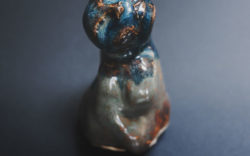“I need to simplify things,” says Alan Palomo from his Brooklyn apartment. The Texas native has spent the last several years living in New York, and is about to hit the road for another North American tour in support of VEGA INTL. Night School, his most recent album as Neon Indian. His comment is pragmatic, prudent, even frugal, but given the sheer scope of last year’s release, with its genre-spanning musical maximalism and rich visual accompaniment, one wonders if simplification is even possible at this point.
In the eight years since Neon Indian’s genesis, with a big push from the blogosphere, Palomo has risen from low-key chillwave stylist to the forefront of alternative and electronic music, garnering consistent critical praise along the way. Though raised in a musical family—his father was a Mexican pop singer, and his brother plays bass in the Neon Indian live band—Palomo attended the University of North Texas in Denton to study film, which shaped the way he approaches music.
“I don’t see myself much as a musician,” he states in earnest. It’s hard to believe at first, but where Palomo’s coming from becomes clearer as he continues, claiming his talents lie more in the realm of production. In that regard, one might best picture him as a man with a vision—able to piece it together on his laptop but in need of a little help from his friends to pull it off in concert.
“It was chock full of shit to figure out,” Palomo says of VEGA, noting how much his writing was influenced by its anticipated live representation. “I do find it really important that it gets replicated correctly.”
In addition to executing the record as accurately as possible, Palomo is utilizing the savvy of collaborators on the road in other ways, too; Julian Gross, drummer for New York art-punks Liars, has provided key support in reimagining VEGA’s late-night kitsch. “We have some neon signs,” Palomo says, discussing the album’s main theme and influence: a cinematic, cartoonish reimagining of New York’s after hours.
With his background and wide knowledge of film, the 27-year-old found inspiration in Martin Scorsese’s 1985 comedy After Hours, translating some of his own night-on-the-town experiences in similarly caricatured fashion. “I feel like there’s a very deliberate disposition,” Palomo says, when the sun goes down and last call draws near. He references the melting pot of backgrounds in the Big Apple, which served as creative fodder—in particular, young people who have yet to be properly acquainted with the night. “They haven’t really learned how to carry themselves in a social situation yet,” he says.
Neon Indian’s absurdist palette is wide, as evidenced by the reggae-tinged “Annie” (Palomo wrote much of the record aboard a Carnival cruise ship) or the smooth synths of “Smut!,” which plays out in the off-limits section of a local video store. The promotional lead up to VEGA even touted a hotline one could call for a free single; “Hey there, sexy,” the voice on the other end said before texting a link to said track.
As Palomo’s laid-back retroism and futuristic electro-pop collide, Neon Indian’s future becomes unclear; the hazy late nights have left the impresario in need of a new outlet—or at least one he hasn’t attended to in some time. “Once I write a record, I need to put on a different hat for a while,” he says.
Time away from Neon Indian has included film, music and the intersection of both. In addition to directing the eight-and-a-half-minute video for VEGA track “Slumlord Rising,” Palomo has written a sci-fi script, scored a movie that appeared at the Toronto International Film Festival and acted in an upcoming Terrence Malick flick. As for whether or not he’ll return to the creative outlet that launched his career across the world wide web, he says, “If Neon Indian were to continue, it would need an overhaul.” Better yet, maybe just some simplification.
Like what you just read? Support Flagpole by making a donation today. Every dollar you give helps fund our ongoing mission to provide Athens with quality, independent journalism.










